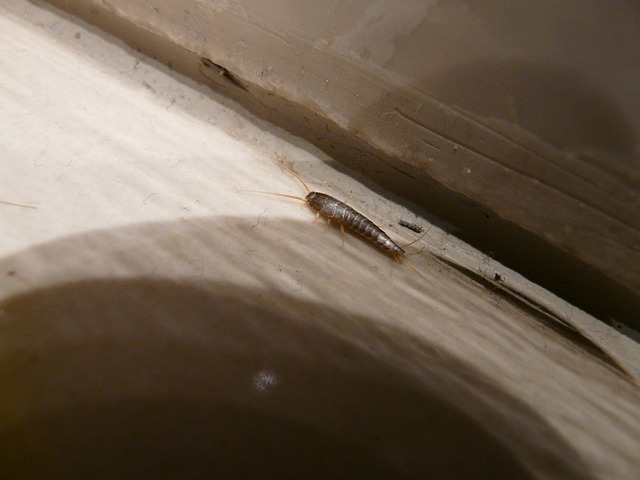Silverfish, adaptable insects with a preference for dark, moist environments, pose challenges due to their rapid reproduction and evasive nature. Professional professional silverfish extermination is crucial for managing infestations, requiring understanding of their biology, behavior, and preferred habitats. Signs like damaged paper products, sticky residues, and oval eggs indicate their presence. Preventive strategies include regular inspections, sealing entry points, eliminating moisture, and maintaining cleanliness. Experts employ advanced techniques, combining specialized equipment with targeted chemicals to reach hiding places, ensuring long-term solutions for professional silverfish extermination. Post-treatment monitoring and hygiene practices prevent reinfestation.
In the realm of pest control, few creatures are as elusive and challenging to eradicate as silverfish. This article guides professionals through an in-depth exploration of silverfish behavior and offers comprehensive solutions for effective prevention and extermination. From understanding the biology and identifying subtle signs of infestation to implementing advanced techniques, we empower experts to tackle these persistent pests head-on. Discover expert strategies for professional silverfish extermination, ensuring a pest-free environment.
Understanding Silverfish: Biology and Behavior
Silverfish, scientifically known as Lepismma saccharina, are small, wingless insects that belong to the family Lepismmatidae. Despite their name, they have no relation to fish; instead, they are part of a diverse group of insects known for their adaptability and survival skills. These creatures are highly elusive, particularly during the day when they hide in dark, moist places like cracks, crevices, and under objects. They emerge at night to forage for food, which primarily consists of starchy materials, including paper products, carbohydrates, and even fabric.
Professional silverfish extermination is often necessary due to their remarkable ability to evade detection and reproduce rapidly. Understanding their biology and behavior is crucial for effective prevention and management. Silverfish have an elongated body with a flat, oval shape, allowing them to squeeze into tight spaces. Their lifespan varies from 3 to 5 years, during which they undergo multiple molts. Females lay eggs in clusters, typically hiding them in protected areas, ensuring the survival of their offspring. Effective professional extermination strategies involve identifying and sealing entry points, eliminating moisture sources, and using targeted treatments to disrupt their breeding cycles.
Identifying Signs of a Silverfish Infestation
Recognizing the signs of a silverfish infestation is the first step towards effective professional silverfish extermination. While these creatures prefer hidden spaces, their presence can be indicated by distinct clues. Keep an eye out for damaged paper products, such as shredded or chewed books and newspapers, which are common feeding grounds for silverfish. These insects also leave behind a trail of sticky substances, often visible on walls, floors, and furniture, marking their pathways to food sources.
Additionally, the presence of silverfish eggs or nymphs—small, oval-shaped creatures—can signal an active infestation. As they are adept at hiding in tight spaces, regular inspections are crucial for early detection. Professional exterminators employ specialized tools and knowledge to identify these subtle signs, ensuring a swift and comprehensive solution to rid your environment of silverfish.
Effective Prevention Strategies for Professionals
Professionals in pest control and property management should implement targeted strategies for silverfish prevention, focusing on proactive measures to minimize infestations. Regular inspections are key; identifying potential entry points and sources of moisture is crucial as silverfish are attracted to dark, damp areas. Implementing a strict cleaning regimen, especially in kitchens and bathrooms, can significantly deter these insects. This includes promptly addressing leaks, wiping down surfaces, and storing food in airtight containers.
Additionally, professionals should recommend clients use pest-repellent products specifically designed for silverfish, focusing on cracks, crevices, and corners where they tend to hide. Sealing entry points like windows, doors, and utility pipes can also be effective long-term solutions. By combining these prevention tactics, professionals in the industry can offer comprehensive services for silverfish extermination while emphasizing the importance of ongoing maintenance.
Advanced Extermination Techniques and Post-Treatment Care
In the realm of professional silverfish extermination, advanced techniques have been developed to ensure efficient and effective control. These methods go beyond traditional pest control practices, employing innovative strategies tailored to the unique behavior of silverfish. Trained professionals utilize sophisticated equipment and chemicals that specifically target these elusive creatures, often hiding in hard-to-reach cracks and crevices. By understanding their habits and habitats, experts can implement targeted treatments, minimizing the use of harsh chemicals and promoting eco-friendly practices.
Post-treatment care is a critical component of successful silverfish extermination. Once the initial treatment is completed, professionals monitor the area closely to ensure the population has been significantly reduced. Regular inspections help identify any remaining silverfish or signs of reinfestation, allowing for prompt action. Proper post-care also involves sealing entry points and maintaining good hygiene practices to prevent future infestations. This comprehensive approach ensures that not only are the current silverfish issues addressed but also that they don’t resurface, providing long-lasting relief for affected properties.
Professionals in pest control can effectively manage and eradicate silverfish infestations through a combination of understanding these insects’ unique biology and behavior, identifying subtle signs of their presence, and employing advanced prevention and extermination techniques. By staying informed about the latest research and best practices in professional silverfish extermination, specialists can ensure lasting results and protect properties from these persistent pests.
